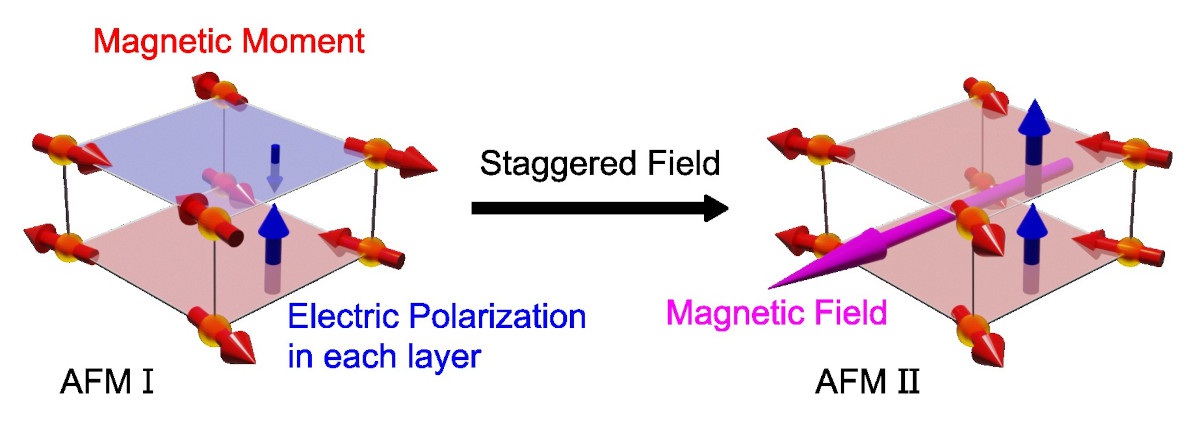Hidden Magnetoelectric Phase Transition by Emergent Staggered Magnetic Field
© The Physical Society of Japan
This article is on
Magnetic-Field-Induced Antiferromagnetic–Antiferromagnetic Phase Transition in Quasi-Two-Dimensional Multiferroic Material Ba2FeSi2O7
J. Phys. Soc. Jpn. 92, 014701 (2023).
Emergent staggered magnetic fields induce phase transition in the multiferroic material Ba2FeSi2O7.
This study established a design principle utilizing emergent staggered magnetic fields to obtain an enhanced physical response.

Magnetic fields are among the most fundamental external fields for manipulating the physical property of magnetic materials. Uniform magnetic fields induce phase transitions to obtain a gain from Zeeman energy, resulting in a metamagnetism characterized by transitions from antiferromagnets (AFMs) to ferromagnets. However, staggered magnetic fields, whose directions are antiparallel between neighboring magnetic atoms, remain relatively unexplored. In contrast to uniform magnetic fields, staggered magnetic fields potentially induce a phase transition between two distinct AFM phases, which is expected to accompany a jump in staggered magnetization.
An interesting application of this new type of phase transition is its usage as a knob for controlling composite order parameters in multiferroics. Multiferroics are a group of materials wherein multiple degrees of freedom, such as spin, charge, and lattice, are mutually coupled. They are considered a promising platform for realizing cost-effective next-generation devices. In multiferroics, unconventional spin degrees of freedom are known to be relevant to describe their unusual behavior. Certain types of staggered magnetic moments are considered to be responsible for ferroelectricity. However, the direct application of a staggered magnetic field in an experimental setup is challenging; this hinders the development of their functionality.
In this study, we observed a magnetic field-induced phase transition from a zero-field AFM phase to another AFM phase in the multiferroic material Ba2FeSi2O7. Consequently, the hidden role of the emergent staggered magnetic field was identified. A key ingredient is the Dzyaloshinskii–Moriya (DM) interaction of relativistic spin-orbit coupling origin, which exists in non-centrosymmetric materials, and facilitates effective conversion of the uniform magnetic field into a staggered magnetic field.
We measured the magnetic field dependence of magnetization and electric polarization of a single crystal Ba2FeSi2O7 and observed a phase transition accompanying electric polarization changes. Using a newly established spin model, the experimental observation was reproduced through mean-field numerical simulations. The simulation results indicate the jump in staggered magnetization at the phase transition, thus validating the proposed scenario. In other words, the phase transition is induced by the emergent staggered magnetic field converted from the applied uniform magnetic field through DM interaction. The fragile nature of the zero-field AFM structure against the emergent staggered magnetic field originates from the low dimensionality of this material, which enables the competition between exchange interaction and relatively weak DM interaction. Thus, our study demonstrated the utilization of the field-induced emergent staggered field to manipulate AFM phases and a design principle of materials.
(written by Y. Watanabe on behalf of all the authors.)
Magnetic-Field-Induced Antiferromagnetic–Antiferromagnetic Phase Transition in Quasi-Two-Dimensional Multiferroic Material Ba2FeSi2O7
J. Phys. Soc. Jpn. 92, 014701 (2023).
Share this topic
Fields
Related Articles
-
Antiferromagnetism Induces Dissipationless Transverse Conductivity
Electronic transport in condensed matter
Magnetic properties in condensed matter
Electronic structure and electrical properties of surfaces and nanostructures
2024-7-24
An investigation using high-quality NbMnP crystals demonstrates that the anomalous Hall conductivity arising from antiferromagnetism is dissipationless, as expected from the intrinsic mechanism.
-
Structural Rotation and Falsely Chiral Antiferromagnetism: A New Combination Generating Ferrotoroidic State
Magnetic properties in condensed matter
Dielectric, optical, and other properties in condensed matter
2024-7-4
The ferrotoroidic state, an exotic state of matter with broken space inversion and time-reversal symmetries, was achieved by combining structural rotation and falsely chiral antiferromagnetism in PbMn2Ni6Te3O18.
-
Understanding Electronic Ordering and Cross Correlations with Multipole Representation
Magnetic properties in condensed matter
2024-6-12
This study reviews the recent advancements in research of multipole representations for understanding electronic orderings and cross-correlations in materials and presents future research directions.
-
Microscopic Exploration of Electronic States in Nickelate Superconductors
Magnetic properties in condensed matter
Superconductivity
2024-5-31
The multilayered nickelates, La3Ni2O7 and La4Ni3O10 , were investigated using nuclear magnetic resonance (NMR) at ambient pressure. Metallic electronic states under the density wave order were observed microscopically for both compounds.
-
Solving a Stochastic Differential Equation is Solving a Mean-Field Quantum Spin System
Statistical physics and thermodynamics
Mathematical methods, classical and quantum physics, relativity, gravitation, numerical simulation, computational modeling
Magnetic properties in condensed matter
2024-5-16
The replica method maps matrix-valued geometric Brownian motion to a mean-field quantum spin system. This correspondence makes it possible to obtain an exact solution for matrix-valued geometric Brownian motion.
